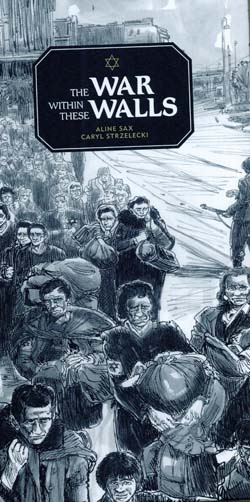Aline Sax, author, and Caryl Strzelecki, illustrator, The War Within These Walls, Eerdman’s Books for Young Readers, 2013, ISBN 978-0-8028-5428-5, 169 pages.
By Donald H. Harrison
 SAN DIEGO — Sometimes I think all of us are too young to learn about the Holocaust, because the more we know the more our souls feel crushed. But learn about the Holocaust we must if we are to prevent it from ever happening again. For years now, Jewish educators have been debating what is the proper age for children to begin learning the details of this terrible episode in man’s brutal history. You can ask Google the question and you’ll find page after page of learned answers, not all of them in agreement.
SAN DIEGO — Sometimes I think all of us are too young to learn about the Holocaust, because the more we know the more our souls feel crushed. But learn about the Holocaust we must if we are to prevent it from ever happening again. For years now, Jewish educators have been debating what is the proper age for children to begin learning the details of this terrible episode in man’s brutal history. You can ask Google the question and you’ll find page after page of learned answers, not all of them in agreement.
The publishers at Eerdman’s Book for Young Readers recommend that their latest book, The War Within These Walls, written by Aline Sax and graphically illustrated in pen and Chinese ink by Caryl Strzeleck, be read by teenagers 14 and up, which makes me wince for those youngsters’ innocence soon to be lost. But I suppose from the standpoint of Jewish tradition, 14 is just about the right age as it comes a full year after bar or bat mitzvah, 365 days after our kids have taken on the spiritual responsibilities of adults.
The book is a fictional account of the Warsaw Ghetto — fictional in that the protagonist is a young boy whom the author invented. But it is historical in that all situations which are described in the book are well documented: The invasion of Poland, the humiliation and dehumanization of the Jews, their being forced into a ghetto, their dying from starvation, their being shipped from the Warsaw Ghetto to the Auschwitz death camp, and finally, their being led by Mordecai Anielewicz in an uprising against the Nazis, knowing that they either could die fighting or be murdered.
Strzelecki’s illustrations in black and gray help children picture the Holocaust–and to be honest, when I think of it, I never imagine it in color, always in a grim black and white. Don’t you also?
Sax’s writing is often quite stark, and this is the kind of passage that I worry about our kids reading. However, though it causes us to shudder, we know that such incidents happened all too often:
The soldier kicked over the baby carriage
A bundle of blankets fell onto the ground and started to wail.
The woman reached for the baby.
The soldier grabbed the child by one leg.
The child shrieked. The mother screamed.
The soldier slammed the child against the wall.
I closed my eyes.
But I couldn’t close my ears.
The woman’s scream was stopped by a shot.
*
Harrison is editor of San Diego Jewish World. He may be contacted via donald.harrison@sdjewishworld.com